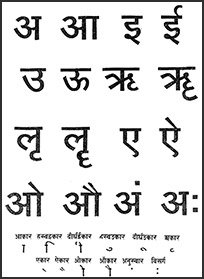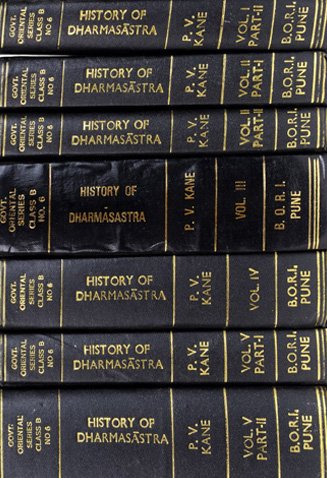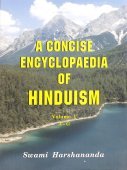Vyakarana, Vyākaraṇa: 28 definitions
Introduction:
Vyakarana means something in Buddhism, Pali, Hinduism, Sanskrit, the history of ancient India, Marathi, Hindi. If you want to know the exact meaning, history, etymology or English translation of this term then check out the descriptions on this page. Add your comment or reference to a book if you want to contribute to this summary article.
Alternative spellings of this word include Vyakaran.
In Hinduism
Purana and Itihasa (epic history)
Source: Cologne Digital Sanskrit Dictionaries: The Purana IndexVyākaraṇa (व्याकरण).—Pāṇini's grammar.*
- * Brahmāṇḍa-purāṇa III. 19. 22; Vāyu-purāṇa 83. 52; Viṣṇu-purāṇa V. 1. 38.

The Purana (पुराण, purāṇas) refers to Sanskrit literature preserving ancient India’s vast cultural history, including historical legends, religious ceremonies, various arts and sciences. The eighteen mahapuranas total over 400,000 shlokas (metrical couplets) and date to at least several centuries BCE.
Vyakarana (Sanskrit grammar)
Source: Wikisource: A dictionary of Sanskrit grammarVyākaraṇa (व्याकरण).—Grammar the development of the meaning of the term can be seen by the senses given below in a serial order and the examples after those senses; (a) analysis or explanation by analysis; (b) rules of explanation; (c) specific rules explaining the formation of words; d) explanation of the formation of rules; (e) a treatise in which such an explanation is given; (f) a collection of such treatises and (g) a systematic explanation of the formation of words in a language (व्याकरणशास्त्र (vyākaraṇaśāstra) or शब्दानुशासन (śabdānuśāsana)); cf.(a) व्यक्रियते अनेन इति व्याकरणम् (vyakriyate anena iti vyākaraṇam) ; M.Bh.on Ahnika 1, Vart. 12: cf. (b) लक्ष्यलक्षणे व्याकरणम् (lakṣyalakṣaṇe vyākaraṇam); M. Bh. Ahnika 1, Vart. 14; cf. (c) न यथा लोके तथा व्याकरणे (na yathā loke tathā vyākaraṇe) M. Bh. on P. I. 1.1. Vart. 7; (d) सर्वत्रैव हि व्याकरणे पूर्वोच्चारितः संज्ञी परोच्चारिता संज्ञा (sarvatraiva hi vyākaraṇe pūrvoccāritaḥ saṃjñī paroccāritā saṃjñā) M. Bh.on P. I. 1.1. Vart 7; (e) न तथा लोके यथा व्याकरणे (na tathā loke yathā vyākaraṇe) M.Bh. on P, I. 1.23 Vart. 4; cf.(f)इह च व्याकरणे शब्दे कार्यस्य संभवः, अर्थं असंभवः । (iha ca vyākaraṇe śabde kāryasya saṃbhavaḥ, arthaṃ asaṃbhavaḥ |) M. Bh. on P. I. 1.68. cf. (g) व्याकरणं नाम इयमुत्तरा विद्या । (vyākaraṇaṃ nāma iyamuttarā vidyā |) M. Bh. on P. I. 2.32. The word व्याक-रण (vyāka-raṇa) is mostly used in the sense of ’the Science of Grammar' in the Mahabhasya. It is explained by modern scholars as 'the law of the corrections of speech and etymological science' and described both as a science and an art.
Source: Knowledge Traditions & Practices of India: Language and Grammar (vyakarana)Vyākaraṇa (व्याकरण, “grammar”) refers to the “an instrument of division or analysis” and represents one of the six vedāṅgas: disciplines developed in order to articulate and interpret sacred texts (such as the Ṛgveda).—The breaking-down of a continuous text into its parts such as sentences and words is not possible without some knowledge of vyākaraṇa, literally “an instrument of division or analysis”. The scholars who prepared these lists of nouns or verbs were the first grammarians. In Sanskrit, several such lists have been made for both compositional / written (vaidikī) and spoken language (laukikī).
The tradition holds that there was a long tradition of grammatical thinking before Pāṇini. Pāṇini (7th century BCE) in the Aṣṭādhyāyī refers to the works of ten grammarians such as Āpiśali, Kāśyapa, Gārgya and others. Eighty-five grammarians before Pāṇini are known to us by name.

Vyakarana (व्याकरण, vyākaraṇa) refers to Sanskrit grammar and represents one of the six additional sciences (vedanga) to be studied along with the Vedas. Vyakarana concerns itself with the rules of Sanskrit grammar and linguistic analysis in order to establish the correct context of words and sentences.
Dharmashastra (religious law)
Source: Knowledge Traditions & Practices of India: Education: Systems & PracticesVyākaraṇa (व्याकरण, “grammar”) refers to one of the six divisions of the Vedāṅga texts, a type of Śāstra categorised as Apaurūṣeya; all part of the ancient Indian education system, which aimed at both the inner and the outer dimension of a person.

Dharmashastra (धर्मशास्त्र, dharmaśāstra) contains the instructions (shastra) regarding religious conduct of livelihood (dharma), ceremonies, jurisprudence (study of law) and more. It is categorized as smriti, an important and authoritative selection of books dealing with the Hindu lifestyle.
Yoga (school of philosophy)
Source: ORA: Amanaska (king of all yogas): A Critical Edition and Annotated Translation by Jason BirchVyākaraṇa (व्याकरण) refers to “grammar”, according to the Amanaska Yoga treatise dealing with meditation, absorption, yogic powers and liberation.—Accordingly, as Īśvara says to Vāmadeva: “[...] Not by studying the doctrines of scriptural exegesis, logic, planets and mathematics, nor by the Vedas, Upaniṣads, Dharmaśāstras [and the like]; not even by lexicons nor metre, grammar (vyākaraṇa), poetry nor rhetoric; the sage's attainment of the highest reality is gained only from the oral teachings of his own guru.[...]”.

Yoga is originally considered a branch of Hindu philosophy (astika), but both ancient and modern Yoga combine the physical, mental and spiritual. Yoga teaches various physical techniques also known as āsanas (postures), used for various purposes (eg., meditation, contemplation, relaxation).
General definition (in Hinduism)
Source: WikiPedia: HinduismVyākaraṇa (व्याकरण) is the study of grammar and linguistic analysis in Sanskrit language. Vyākaraṇa literally means “explanation, analysis”, and also refers to one of the six ancient Vedāṅgas, or ‘ancillary science’, connected with the Vedas (the scriptures of Hinduism).
In Buddhism
Mahayana (major branch of Buddhism)
Source: Wisdom Library: Maha Prajnaparamita Sastra1) Vyākaraṇa (व्याकरण) refers to the four ways of “answering” according Mahāprajñāpāramitāśāstra (chapter IV). There are four ways of answering (vyākaraṇa):
- answering in a categorical way (ekāṃśena-vyākaraṇa);
- answering by distinguishing (vibhajya-vyākaraṇa);
- answering by asking a question (paripṛcchā-vyākaraṇa);
- answering by not replying (sthāpanīya-vyākaraṇa).
2) Vyākaraṇa (व्याकरण, “prediction”) refers to one of the twelve members of Buddhist texts (dvādaśāṅga), according to a note attached to the Mahāprajñāpāramitāśāstra chapter 51.—The predictions relating to the nine paths (navamārga) of beings, i.e., (1-3) the paths of the three Vehicles (triyānamārga) and (4-9) the paths of the six destinies (ṣaḍgatimārga) are called vyākaraṇa. Vyākaraṇa can designate a catechesis by means of questions and answers, an explanation or a prediction.
Source: academia.edu: A Study and Translation of the GaganagañjaparipṛcchāVyākaraṇa (व्याकरण) refers to “prediction”, according to the Gaganagañjaparipṛcchā: the eighth chapter of the Mahāsaṃnipāta (a collection of Mahāyāna Buddhist Sūtras).—Accordingly, “Then the Bodhisattva Gaganagañja, having praised the Lord with these verses, addressed himself to the Lord: ‘[...] The Lord, having known the meaning (artha), is skilled in the knowledge of the division of words. The Lord, having known the proper time, is always free of faulty prediction (akṣūṇa-vyākaraṇa). The Lord, having known the proper measure, teaches the dharma accordingly to each individual of all living being.[...]’”.

Mahayana (महायान, mahāyāna) is a major branch of Buddhism focusing on the path of a Bodhisattva (spiritual aspirants/ enlightened beings). Extant literature is vast and primarely composed in the Sanskrit language. There are many sūtras of which some of the earliest are the various Prajñāpāramitā sūtras.
Tibetan Buddhism (Vajrayana or tantric Buddhism)
Source: OSU Press: Cakrasamvara SamadhiVyākaraṇa (व्याकरण) refers to the “promise of future attainment”, according to Buddhist teachings followed by the Newah in Nepal, Kathmandu Valley (whose roots can be traced to the Licchavi period, 300-879 CE).—In the Hīnayāna the term bodhisattva was only used to refer to a future historical Buddha prior to their attainment of Buddhahood. However, in the Mahāyāna, the term is used to designate anyone who aspires to the complete, perfect enlightenment of themselves and all beings. Motivated by boundless compassion (karuṇā), and tempered by the perfection of wisdom (prajñā), the Bodhisattva generates bodhichitta, "the enlightened mind", which many Buddhists believe to be compassion itself. The Bodhisattva then takes the Bodhisattva Vow (praṇidhāna), receives the promise of future attainment (vyākaraṇa), and proceeds to follow the Bodhisattva Path, including the ten stages (bhūmis). [...]

Tibetan Buddhism includes schools such as Nyingma, Kadampa, Kagyu and Gelug. Their primary canon of literature is divided in two broad categories: The Kangyur, which consists of Buddha’s words, and the Tengyur, which includes commentaries from various sources. Esotericism and tantra techniques (vajrayāna) are collected indepently.
General definition (in Buddhism)
Source: Wisdom Library: Dharma-samgrahaVyākaraṇa (व्याकरण, “explanation”) refers to one of the “nine (types of) teachings” (sūtra) as defined in the Dharma-saṃgraha (section 62). The Dharma-samgraha (Dharmasangraha) is an extensive glossary of Buddhist technical terms in Sanskrit (e.g., vyākaraṇa). The work is attributed to Nagarjuna who lived around the 2nd century A.D.
Source: WikiPedia: BuddhismVyākaraṇa (व्याकरण) is also found in Mahāyāna-sūtras but with a different meaning. Vyākaraṇa , in these Buddhist texts, means a prediction or prophecy by a Buddha to a Bodhisattva who has just embarked on the path, that he will achieve enlightenment and be a Buddha.
India history and geography
Source: Singhi Jain Series: Ratnaprabha-suri’s Kuvalayamala-katha (history)Vyākaraṇa (व्याकरण) refers to one of the topics taught at the Educational institutions in ancient India, which attracted students from near and distant countries, as depicted in the Kathās (narrative poems) such as Uddyotanasūri in his 8th-century Kuvalayamālā (a Prakrit Campū, similar to Kāvya poetry).—Page 150.17 f. & 151.1-5: There is described an educational institution which included students from Lāṭa, Karṇāṭaka, Mālava, Kaṇṇujja, Godāvarī (Nasik), Mahārāṣṭra, Saurāṣṭra, Śrīkaṇṭha (Thanesvar) and Sindha. The courses of study comprised [e.g., Vyākaraṇa] [...]. At another place (151.6-11) the prince came across persons who cultivated the seventy-two arts and sixty-four sciences, [...].

The history of India traces the identification of countries, villages, towns and other regions of India, as well as mythology, zoology, royal dynasties, rulers, tribes, local festivities and traditions and regional languages. Ancient India enjoyed religious freedom and encourages the path of Dharma, a concept common to Buddhism, Hinduism, and Jainism.
Languages of India and abroad
Pali-English dictionary
Source: BuddhaSasana: Concise Pali-English Dictionaryvyākaraṇa : (nt.) grammar; explanation; answer; declaration.
Source: Sutta: The Pali Text Society's Pali-English DictionaryVyākaraṇa, (nt.) (fr. vyākaroti; see also veyyākaraṇa) 1. answer (pañha°), explanation, exposition A. I, 197; II, 46; III, 119; SnA 63, 99; KhA 75, 76.—2. grammar (as one of the 6 aṅgas) SnA 447; PvA. 97.—3. prediction J. I, 34, 44; DhA. IV, 120. (Page 653)

Pali is the language of the Tipiṭaka, which is the sacred canon of Theravāda Buddhism and contains much of the Buddha’s speech. Closeley related to Sanskrit, both languages are used interchangeably between religions.
Marathi-English dictionary
Source: DDSA: The Molesworth Marathi and English Dictionaryvyākaraṇa (व्याकरण).—n (S) Grammar.
Source: DDSA: The Aryabhusan school dictionary, Marathi-Englishvyākaraṇa (व्याकरण).—n Grammar.
Marathi is an Indo-European language having over 70 million native speakers people in (predominantly) Maharashtra India. Marathi, like many other Indo-Aryan languages, evolved from early forms of Prakrit, which itself is a subset of Sanskrit, one of the most ancient languages of the world.
Sanskrit dictionary
Source: DDSA: The practical Sanskrit-English dictionaryVyākaraṇa (व्याकरण).—
1) Analysis, decomposition.
2) Grammatical analysis, grammar, one of the six Vedāṅgas q. v.; सिंहो व्याकरणस्य कर्तुरहरत् प्राणान् प्रियान् पाणिनेः (siṃho vyākaraṇasya karturaharat prāṇān priyān pāṇineḥ) Pañcatantra (Bombay) 2.33.
3) Explaining, expounding.
4) Discrimination.
5) Manifestation.
6) Prediction.
7) The sound of a bow-string.
Derivable forms: vyākaraṇam (व्याकरणम्).
Source: Cologne Digital Sanskrit Dictionaries: Edgerton Buddhist Hybrid Sanskrit DictionaryVyākaraṇa (व्याकरण).—nt. (to vyākaroti; in meaning 1 essentially like Sanskrit id.; Pali id. also in meaning 3), (1) explanation, elucida- tion, especially of questions put: praśnasya °ṇena Laṅkāvatāra-sūtra 15.1; dharmaṃ paripṛcchakās, tasya ca °ṇena tuṣṭā(ḥ)…Saddharmapuṇḍarīka 288.12; sarvapraśna-°ṇa- Lalitavistara 427.14; (rājā…) pṛcchati, te ca jñātvā vyākaronti, teṣāṃ vyākaraṇaṃ śrutvā… Mahāvastu i.274.5; °ṇe bhāṣyamāṇe iii.66.17; probably in this sense, persons like the Bodhisattva are called °ṇa-saṃpannāḥ, perfect in elucidation (of religious problems), Mahāvastu ii.290.19 (in one of the reproaches hurled at Māra; compare pratibhāna- saṃpannāḥ 18, just before); so also the Pratyekabuddhas who entered nirvāṇa to ‘empty’ the earth for the birth of Śākyamuni are said to have vyākaraṇāni vyākaritvā Mahāvastu i.357.9, 11, before entering nirvāṇa; in this case the vyākaraṇāni are the khaḍgaviṣāṇa gāthās appropriate to Pratyekabuddhas; there are four technical kinds of °ṇa, [Page517-a+ 71] answers to questions, in Mahāvyutpatti 1657—61, ekāṃśa-, vibhajya-, paripṛcchā-, and sthāpanīya-°ṇa, qq.v.; as one of the 12 or 9 types of literature in the canon, °ṇam Mahāvyutpatti 1269; Dharmasaṃgraha 62, explanation, perhaps more specifically answers to questions, = vaiyākaraṇa, Pali veyyākaraṇa (which according to Majjhimanikāya (Pali) commentary ii.106.13 means all the Abhidhamma, suttas without gāthās, and whatever else is not included in the other 8 divisions!); not predictions with Burnouf Intr. 54 ff. and Lévi on Asaṅga (Mahāyāna-sūtrālaṃkāra) i.7; (2) vyākaraṇaḥ, m., Avadāna-śataka ii.19.8 (see Speyer's note), if correct would be nom. ag., expounder, elucidator; parallels Divyāvadāna 619.24; 620.19 vaiyākaraṇaḥ, in Sanskrit and perhaps here grammarian; (3) (as in Pali, not Sanskrit) prophecy, prediction, recorded only of a prediction that someone will attain perfect enlightenment (tho the verb vyākaroti is not so restricted); in this sense very common, regularly with gen. of the person (or in composition) and loc. of the goal: Śāriputrasyedaṃ °ṇam anuttarāyāṃ samyaksambodhau Saddharmapuṇḍarīka 69.6; similarly Saddharmapuṇḍarīka 70.12; 214.3, 4; 222.12, etc. etc.; megha-māṇavaka-°ṇaṃ Mahāvastu i.2.1; °ṇaṃ…labheyā Bhadracarī 59, may I get a prophecy; apramāṇa-°ṇa-pratyeṣakaś Daśabhūmikasūtra 71.24; others, Suvarṇabhāsottamasūtra 168.4 etc., common everywhere; exceptionally, with loc. of beneficiary, gen. of maker of the prophecy, vyākaraṇam asmi (mss. asmiṃ) dyutimatŏ Mahāvastu i.43.18, so read, the Glorious One's prophecy about him.
Source: Cologne Digital Sanskrit Dictionaries: Shabda-Sagara Sanskrit-English DictionaryVyākaraṇa (व्याकरण).—n.
(-ṇaṃ) 1. The science of grammar, considered as one of the six Vedangas. 2. Explaining, expounding. E. vi and āṅ before kṛ to make or do, lyuṭ aff.
Source: Cologne Digital Sanskrit Dictionaries: Benfey Sanskrit-English DictionaryVyākaraṇa (व्याकरण).—i. e. vi-ā-kṛ + ana, n. 1. Explaining. 2. Grammar, [Pañcatantra] 4, 14; ii. [distich] 34.
Source: Cologne Digital Sanskrit Dictionaries: Cappeller Sanskrit-English DictionaryVyākaraṇa (व्याकरण).—[neuter] putting asunder, [substantive] paration; explanation, manifestation; analysis, grammar.
Source: Cologne Digital Sanskrit Dictionaries: Monier-Williams Sanskrit-English Dictionary1) Vyākaraṇa (व्याकरण):—[=vy-ākaraṇa] a etc. See vy-ā-√kṛ.
2) [=vy-ākaraṇa] [from vyā-kṛ] b n. separation, distinction, discrimination, [Mahābhārata]
3) [v.s. ...] explanation, detailed description, [ib.; Suśruta]
4) [v.s. ...] manifestation, revelation, [Mahābhārata; Harivaṃśa]
5) [v.s. ...] (with Buddhists) prediction, prophecy (one of the nine divisions of scriptures, [Dharmasaṃgraha 62]), [Saddharma-puṇḍarīka] etc.
6) [v.s. ...] development, creation, [Śaṃkarācārya; Bhāgavata-purāṇa]
7) [v.s. ...] grammatical analysis, grammar, [Muṇḍaka-upaniṣad; Patañjali; Mahābhārata] etc.
8) [v.s. ...] grammatical correctness, polished or accurate language, [Subhāṣitāvali]
9) [v.s. ...] the sound of a bow-string, [cf. Lexicographers, esp. such as amarasiṃha, halāyudha, hemacandra, etc.]
Source: Cologne Digital Sanskrit Dictionaries: Yates Sanskrit-English DictionaryVyākaraṇa (व्याकरण):—[vyā-karaṇa] (ṇaṃ) 1. n. Grammar.
Source: DDSA: Paia-sadda-mahannavo; a comprehensive Prakrit Hindi dictionary (S)Vyākaraṇa (व्याकरण) in the Sanskrit language is related to the Prakrit word: Vāgaraṇa.
[Sanskrit to German]
Sanskrit, also spelled संस्कृतम् (saṃskṛtam), is an ancient language of India commonly seen as the grandmother of the Indo-European language family (even English!). Closely allied with Prakrit and Pali, Sanskrit is more exhaustive in both grammar and terms and has the most extensive collection of literature in the world, greatly surpassing its sister-languages Greek and Latin.
Hindi dictionary
Source: DDSA: A practical Hindi-English dictionaryVyākaraṇa (व्याकरण) [Also spelled vyakaran]:—(nm). Grammar; —, [aitihāsika] historical Grammar; —, [tulanātmaka] comparative Grammar; —, [rūpāṃtaraṇa] transformational Grammar; —, [varṇanātmaka] descriptive Grammar; —[viṣayaka/saṃbaṃdhī] grammatical; —, [vyavasthāpaka] systematic Grammar; -[sammata/~siddha] grammatically correct.
...
Kannada-English dictionary
Source: Alar: Kannada-English corpusVyākaraṇa (ವ್ಯಾಕರಣ):—
1) [noun] a separating or breaking up of a whole into its constituent parts for purpose of examination; an analysis.
2) [noun] that part of the study of language which deals with the forms and structure of words (morphology), with their customary arrangement in phrases and sentences; grammar.
Kannada is a Dravidian language (as opposed to the Indo-European language family) mainly spoken in the southwestern region of India.
See also (Relevant definitions)
Partial matches: Vy, Vya, Karana, Akarana.
Starts with (+19): Vyakarana Sutta, Vyakarana-dana-mandapa, Vyakaranacandrika, Vyakaranadarshana, Vyakaranadhundhika, Vyakaranadhyayanaprayojana, Vyakaranadipa, Vyakaranadipavyakarana, Vyakaranadipika, Vyakaranadurghatodghata, Vyakaranagama, Vyakaranagrantha, Vyakaranajna, Vyakaranaka, Vyakaranakara, Vyakaranakarika, Vyakaranakaundinya, Vyakaranakaustubha, Vyakaranakhandana, Vyakaranamahabhashya.
Ends with (+46): Aitihasika-vyakarana, Akhyatavyakarana, Avishrantavidhyadharavyakarana, Avyakarana, Balavyakarana, Bhaimavyakarana, Bhandirabhashavyakarana, Bhojavyakarana, Candravyakarana, Canguvyakarana, Chandasavyakarana, Chandra-vyakarana, Dhatuvyakarana, Dipakavyakarana, Dipavyakarana, Drutabodhavyakarana, Garbhavyakarana, Garbhinivyakarana, Harinamamrita vaishnavavyakarana, Harinamamritavaishnavavyakarana.
Full-text (+362): Vedanga, Vaiyakarana, Jaumara, Vyakaranadipavyakarana, Vyakaranaprakriya, Vyakaranadhundhika, Vyakaranadurghatodghata, Vyakaranatraya, Vyakaranasara, Vyakaranadipa, Vyakaranakhandana, Vyakaranamula, Vyakaranadipika, Vyakaranasamgraha, Vyakaranakaustubha, Vyakaranamahabhashya, Vyakaranavadagrantha, Vyakaranakaundinya, Vyakaranasiddha, Vyakartritva.
Relevant text
Search found 93 books and stories containing Vyakarana, Vyākaraṇa, Vy-akarana, Vy-ākaraṇa, Vya-karana, Vyā-karaṇa; (plurals include: Vyakaranas, Vyākaraṇas, akaranas, ākaraṇas, karanas, karaṇas). You can also click to the full overview containing English textual excerpts. Below are direct links for the most relevant articles:
Taittiriya Upanishad Bhashya Vartika (by R. Balasubramanian)
Verse 2.374 < [Book 2 - Brahmavallī]
Maha Prajnaparamita Sastra (by Gelongma Karma Migme Chödrön)
Part 2 - Hearing the twelve-membered speech of the Buddha < [Chapter LI - Seeing all the Buddha Fields]
II.7. Other qualities of the Buddhist Dharma < [II. Recollection of the Dharma (dharmānusmṛti)]
II. The pratisaṃvids according to the Mahāyāna < [Part 3 - The four unhindered knowledges]
Vakyapadiya of Bhartrihari (by K. A. Subramania Iyer)
Verse 3.14.68 < [Book 3 - Pada-kāṇḍa (14): Vṛtti-samuddeśa (On Ccomplex Formation)]
Verse 2.81 < [Book 2 - Vākya-kāṇḍa]
Verse 2.83 < [Book 2 - Vākya-kāṇḍa]
Chaitanya Bhagavata (by Bhumipati Dāsa)
Verse 1.13.136-137 < [Chapter 13 - Defeating Digvijayī]
Verse 2.17.6 < [Chapter 17 - The Lord’s Wandering Throughout Navadvīpa and Descriptions of the Devotees’ Glories]
Verse 1.12.11 < [Chapter 12 - The Lord’s Wandering Throughout Navadvīpa]
Shishupala-vadha (Study) (by Shila Chakraborty)
Warfare and Military System in Vedic Literature (by Rinki Deka)
A Brief Note on the Vedic Literature < [Chapter 1 - Introduction]
The Status of the Royal Priest and His Characteristics < [Chapter 3 - The Religious observances and other Beliefs related to the Warfare]
Related products
